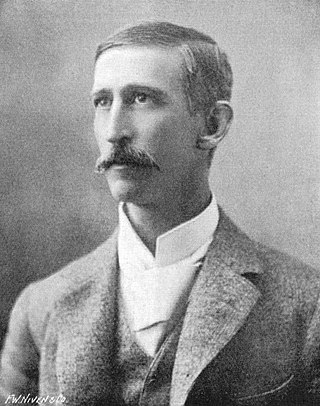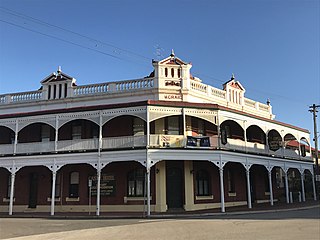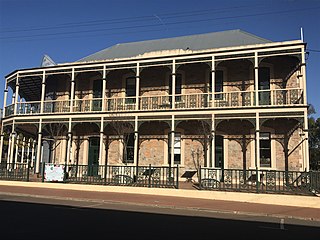Related Research Articles

York is the oldest inland town in Western Australia, situated on the Avon River, 97 kilometres (60 mi) east of Perth in the Wheatbelt, on Ballardong Nyoongar land, and is the seat of the Shire of York.
Thomas Brown was an early settler in colonial Western Australia, and a Member of the Western Australian Legislative Council.
Midgegooroo was an Aboriginal Australian elder of the Nyungar nation, who played a key role in Aboriginal resistance to white settlement in the area of Perth, Western Australia. Everything documented about Midgegooroo is mediated through the eyes of the colonisers, some of whom, notably G.F. Moore, Robert Menli Lyon and Francis Armstrong, derived their information from discussions with contemporary Noongar people, in particular the son of Midgegooroo, Yagan. Largely due to his exploits in opposing colonisation and his relationship with Lyon and Moore, Yagan has a much sharper historical profile than his father. Midgegooroo was executed by firing squad and without trial under the authority of Lieutenant Governor Frederick Irwin in 1833.
Rivett Henry Bland was an early settler and a government administrator in colonial Australia.

York railway station is a disused station on the Eastern Railway in Western Australia. It is located in the town of York.

Frederick Charles Monger was an Australian businessman and politician who was a member of the Legislative Assembly of Western Australia from 1892 to 1903 and again from 1905 to 1914, representing the seat of York. He and his father, John Henry Monger, were the first father–son pair to be elected to the Parliament of Western Australia.

Avon Terrace it is the main street of the town of York, Western Australia, and is lined with heritage buildings.

Faversham House is a heritage-listed "grand residence" overlooking Avon Terrace in York, Western Australia. The house, named after the birthplace of John Henry Monger Snr, was built in four stages by the Monger family.

The Castle Hotel in York is one of the oldest surviving hotels in Western Australia. Its first proprietor was Samuel Craig and it was then held by members of the Craig family for 137 years.

The Imperial Hotel was the first hotel to be built in York, Western Australia that adopted the new "Australian hotel" style in hotel design, with a dominant position on a main street corner block, high and ornate double verandahs surrounding the façade and a main entrance onto the street. The building is in Victorian Filigree style.
John Henry Monger Snr (1802–1867) arrived in Western Australia as an assisted migrant in 1829. After a short period running a mill at what became Lake Monger, he established a hotel and store in York and went on to become one of the richest men in the colony.

The Uniting Church, York is a Uniting church located in Grey Street, York, Western Australia. The church building was established by the Methodist Church in 1888 as the Wesleyan Church, and together with the former chapel, the buildings are significant early buildings of the York settlement.
Walkinshaw Cowan was private secretary to Western Australian Governors John Hutt, Andrew Clarke and Frederick Irwin, then in 1848 he became Guardian of Aboriginals and a justice of the peace, and then resident magistrate at York from 1863 to 1887.
Cowits was Western Australia's first Aboriginal policeman, and was a member of a number of early exploratory expeditions.
Arthur Trimmer (1805–1877) was one of three brothers who were early settlers in the colony of Western Australia. He was the grandson of Sarah Trimmer (1741–1810), an educational reformer and writer.
Peter Barrow was a son of Sir John Barrow, 1st Baronet, and an early settler in the colony of Western Australia, becoming a magistrate and Guardian of Aborigines, Anglican priest and school teacher in York, Western Australia. He left the colony after two years and became a British consul.
John Taylor (1821-1890), son of an Oxford carpenter, was a settler to York, Western Australia who arrived in 1841, was indentured to Thomas Brown, leased and then purchased Yangedine, used progressive machinery, and built a farming estate.
Samuel Smale Craig (1802-1864), and his wife Mary were settlers to York, Western Australia who arrived in 1850 and then built the Castle Hotel, which was then run by the Craig family for 137 years.
Joseph Pyke (1831–1910) was a shoemaker who settled in York, Western Australia in 1857 with his wife, Elizabeth, and became a prominent store keeper and land owner in the town, developing the first street-front shops, and taking a significant role in town affairs.
Eliza Brown was an early settler in colonial Western Australia whose letters to her father record the hardships of her family. She accompanied an exploration to Champion Bay in 1851, her account of the journey being published.
References
- 1 2 3 4 5 6 7 8 A colonist of forty-four years, and goldfields pioneer: Mr William Marwick. Eastern Districts Chronicle, 6 February 1897, p.3.
- 1 2 3 4 5 6 7 8 Conservation Plan for Marwick's Shed by Kevin Palassis.
- ↑ Marwick's Diary 1923, Tipperary Farm.
- 1 2 Wisbech Emigrants of seventy years ago: Nonagenarian's experiences in Western Australia, The Isle of Ely and Wisbech Advertiser, 29 August 1923.
- 1 2 3 4 5 6 Bill Marwick: The Marwicks of York, 2011, ISBN 978-0-9750092-2-2.
- ↑ Eastern Districts Chronicle, 20 July 1917, p.3.
- ↑ Eastern Districts Chronicle, 27 July 1917, p.3.
- ↑ Eastern Districts Chronicle, 3 August 1917, p.3.
- 1 2 Eastern Districts Chronicle, 17 August 1917, p.3.
- ↑ Wisbech Emigrants of seventy years ago: Nonagenarian's experiences in Western Australia, The Isle of Ely and Wisbech Advertiser, 29 August 1923.
- ↑ Perth Gazette and Independent Journal of Politics and News, 30 March 1866, p.2.
- ↑ Eastern Districts Chronicle, 24 November 1877, p.2.
- ↑ Bill Marwick, conversation with Rachel Plugg, 1 March 1999; Conservation Plan p.34
- ↑ Eastern Districts Chronicle, 6 July 1917, p.3.
- 1 2 Eastern Districts Chronicle, 17 April 1925, p.3.
- ↑ Eastern Districts Chronicle, 7 May 1898, p.2.
- ↑ Eastern Districts Chronicle, 11 December 1914, p.5.